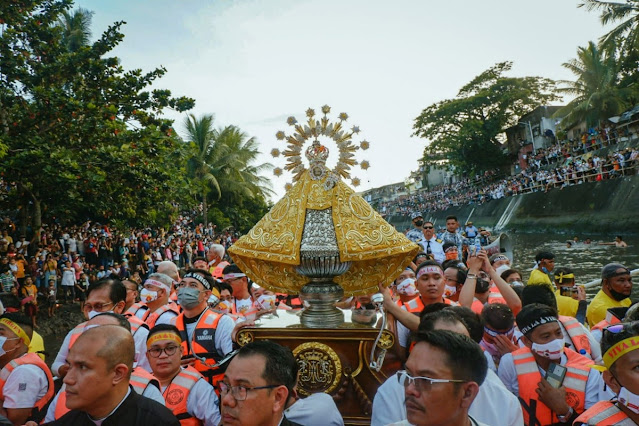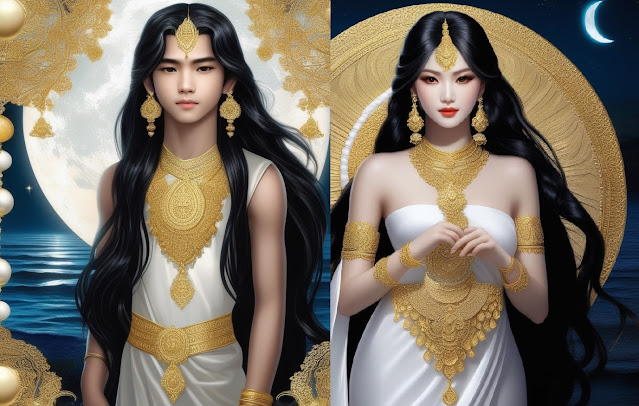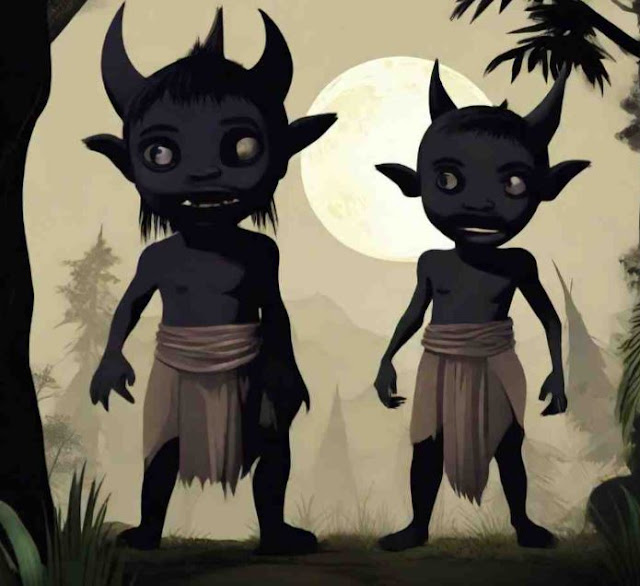 |
| Handiong |
Handyong (Handiog) is a mythological Hero in Philippine mythology, specifically in Bicol. The Towering Hero of Ibalong, depending on the version of the story some say he has blood from or descended from the ''Tawong Lipod'' apsaras or apsara (Sanskrit: अप्सरा)
.jpeg)
Handiong, in Bicol mythology, is a legendary hero who played a crucial role in the transformation of the land. Arriving in Bicol after Baltog, Handiong became the most famous among the tawong-lipod. He embarked on a heroic journey, clearing the region of menacing creatures such as one-eyed, three-throated beasts, winged sharks, wild carabaos, and man-eating crocodiles.A significant adversary in Handiong's quest was Oryol, a beautiful demigoddess with the lower part of her body resembling a giant snake. Despite attempts to trap her, Oryol's intelligence thwarted the efforts, leading to a captivating battle. Eventually, the two warriors gained mutual respect and fell in love. Oryol, with her serpent form, revealed the secrets of governing the lands to Handiong.Together, Handiong and Oryol cleaned the land of monsters, leading to the flourishing of Bicol. Their triumph over giant crocodiles, known as Buwaya, turned the Bicol River red with blood. The survivors, including Sarimao, were banished and sealed away inside Mount Kulasi.
 |
| Handiong |
Handiong's success resulted in the establishment of settled communities marked by advancements in boat-building, agriculture, and the creation of tools and utensils. Laws were enacted to ensure equality, protect life and honor, fostering a sense of order and respect for heritage.The epic also recounts the earlier arrival of people led by Baltog, who settled in Tundol, facing challenges with beasts and strange creatures. Their prayers to the sun and moon gods paved the way for the establishment of a new colony.From a distant land, men led by a tall, muscular leader named Handyong arrived, seeking to purge the land of non-human creatures. After battling one-eyed monsters and giant flying fishes, the warriors successfully enslaved the fierce Tamaraw.
.jpeg)
However, the creatures of Ibalon, including Sarimao and the Buaya, fought back. Asuang, the lord of all monsters, recognized the end of the monster era, signaling the age of man. Oryol intervened to stop the foreign warriors, but her love for Handyong led to their collaboration in cleaning the land.Despite years of prosperity under Handiong's leadership, the gods intervened, causing storms and chaos. The tragic love story of Onos and Takay resulted in deluge and floods. The moon gods, Bulan and Haliya, transformed Takay into flowers, while a great beast named Rabot posed a new threat to Ibalong.Handiong's friend, Bantong, successfully killed Rabot, but the victory left Handiong saddened, symbolizing the passing of an era. The narrative concludes with a foreshadowing of the coming subjugation of the Spaniards, as men prove to be more vicious than monsters.
 |
| Handyong |
Handyong's Quest: Purging the Land and Building a Golden Age
Enter Handyong, the central figure in the epic and the most renowned among the tawong-lipod. Arriving in Bicol with his followers after Baltog, Handyong's mission was clear – to cleanse Ibalong of predatory monsters and establish a new golden age. His exploits and battles against mythical creatures became the stuff of legends.
Handyong and his warriors faced formidable foes, from the one-eyed monster in Ponong to the giant flying fishes Tiburon. They tamed the fierce Tamaraw, defeated the Sarimao and Buaya, and purged the land of its mythic creatures. The rivers and swamps of Ibalong turned red with the blood of these creatures as Handyong set the stage for a new era.
The intervention of Oryol, a beautiful demigoddess, added intrigue to the narrative. Initially adversaries, Handyong and Oryol's story evolved into a tale of love, respect, and shared governance. Oryol's revelation of the secrets of the gods and beasts played a pivotal role in the flourishing of Bicol under Handyong's rule.
Under Handyong's leadership, Ibalong blossomed into a rich and bountiful land. Colonies were established in Isarog, progress flourished, and inventors emerged, bringing forth tools and technologies. Handyong's laws fostered equality and respect, creating a society where even slaves were dignified.
 |
| Handiong |
The Battles and Triumphs of Handyong
Handyong's journey was marked by epic battles against formidable adversaries. From the one-eyed monster in Ponong to the lair of giant flying fishes known as Tiburon, Handyong and his warriors fought tirelessly, never resting until each monster was vanquished. The fierce Tamaraw was tamed, and the Sarimao, Buaya, and other mythical creatures were driven away, cleansing the land.
The rivers and swamps of Ibalong turned red with the blood of these creatures as Handyong systematically rid the land of its supernatural inhabitants. As Asuang, the lord of all monsters, acknowledged the end of the monsters' reign, Handyong's warriors, blessed by the moon god, stood as a formidable force against the mythical beings.
The Love Story of Oryol and the Flourishing of Ibalong
In the midst of Handyong's quest, a captivating love story unfolded with Oryol, a beautiful demigoddess. Initially a formidable adversary, Oryol's intelligence and allure captured Handyong's attention. The two engaged in a fierce battle, but respect for each other's strength blossomed into love.
Oryol, half-human and half-serpent, played a crucial role in Handyong's journey. Her revelation of the secrets of governing the lands contributed to the flourishing of Bicol. The demigoddess, once an obstacle, became an ally in Handyong's quest to cleanse Ibalong of monsters and build a prosperous society.
Handyong's Contributions to Progress and Innovation
Under Handyong's leadership, Ibalong transformed into a rich and bountiful land. Colonies were established in Isarog, and a season of progress followed. The people planted rice, named after Handyong, and under his good example, inventors emerged, bringing forth tools and technologies that enriched daily life.
Ginantong crafted the plow, harrow, and other farming tools. Hablom invented the first loom for weaving abaca clothes. Dinahon, an Aeta, created essential kitchen utensils. Sural thought of the alphabet and initiated the practice of writing on white rock. Ibalong, under Handyong's rule, became a hub of innovation and progress.
The Gods Intervene: A Tragic Turn of Events
However, the gods, represented by Onos and Gugurang, intervened, introducing tragedy to the narrative. The forbidden love between Onos and the mortal Takay unleashed destruction upon Ibalong. The subsequent spurning of the gods by mortals, symbolized by the destruction of Rabot, marked the end of an era.
The gods' wrath, expressed through natural disasters and the demise of Rabot, signaled a shift in the dynamics of Ibalong. Handyong, curiously saddened by Rabot's death, could be interpreted as a foreboding of the looming subjugation of the Spaniards, hinting at a changing tide in the land's history.
the legends of Baltog and Handyong in Bicol mythology not only entertain but also impart valuable lessons. These tales speak of courage, resilience, and the consequences of challenging the divine order. As the epic of Ibalong continues to be passed down through generations by Kadunung, the echoes of Baltog and Handyong's valor linger, inspiring a sense of identity and pride in the hearts of the people of Bicol.
REMINDER
The orally transmitted mythology of the Philippines is intended for sharing and understanding, not for appropriation, commercial exploitation, or the promotion of foreigners and foreign products. It is a dynamic narrative tradition that evolves over time, distinct from the standardized mythologies found in Western and European cultures. Unlike these established mythologies, the Philippine government has not mandated standardized versions of stories and legends.
Orally transmitted stories undergo variations and evolve over time, resulting in numerous different versions. There are many different version told by Filipinos,and retold by Filipinos.



.jpeg)

.jpeg)


.jpeg)
.jpeg)
.jpeg)
.jpeg)
.jpeg)
.jpeg)
.jpeg)
.jpeg)
.jpeg)
.jpeg)
.jpg)
.jpeg)
.jpg)


.jpeg)
.jpeg)




.jpeg)
.jpeg)







.JPG)
.JPG)







